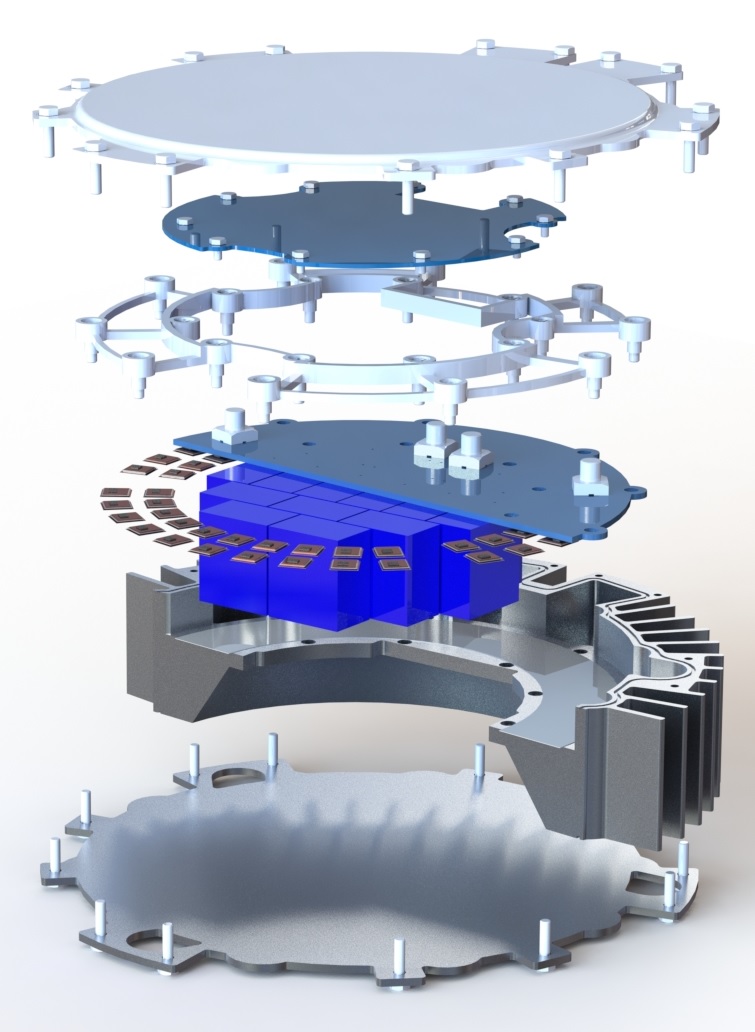Insulated Single Chip Packages for Urban Air Mobility
The TELEV project (Technological enablement of hybrid-electric propulsion systems for manned aircraft through research into aviation-compatible power electronics, distribution and control) aims to systematically investigate the technologies required to bring such configurations up to the performance level required for aviation. To this end, technologies for aviation-compatible power electronics and distribution as well as control systems were specifically researched. Fraunhofer IZM has focused on the development of an air-cooled drive converter for the rotor of an eVTOL (Electric Vertical Take-Off and Landing Vehicle), in particular on the core component, the power modules. The aim is to achieve an efficiency of 99% in order to minimize the battery mass and increase the range.
To achieve this ambitious goal, the focus is on two innovations: firstly, the development of isolated single-chip packages for the power semiconductors and, secondly, the design of a sophisticated air cooling concept based on two spreading mechanisms.
Heat distribution in the inverter Firstly, the concentrated heat loss from the single chip package used (SMD component with an embedded MOSFET) is first conducted vertically and then horizontally to the cooling fins located on the outer surface. This achieves a large spread and distributes the heat over the entire length of the cooling fins.
Secondly, the total of 60 SiC MOSFETs of the B6 bridge are distributed over the entire circumferential surface of the housing. This physical distribution of the semiconductors means that the heat loss is transferred to the heat sink over a large area already during its generation. This means that additional fluid cooling infrastructure can be avoided, resulting in weight savings and increased reliability.
The single chip package
The second innovation lies in the development of single chip packages. With the help of PCB embedding technology, an established, largeformat and inexpensive manufacturing process, the individual chips are embedded and a ceramic base insulation is added to the underside. The implemented single chip, a 1200 V SiC MOSFET, is easily interchangeable with all common power semiconductors, primarily SiC. The voltage class can also be further increased to at least 3.3 kV types.
This turns a fragile, non-insulated bare die, which is very complex to handle, into a robust and easy-to-handle SMD component with a low-impedance thermal path to the heat sink, basic electrical insulation and creepage distance requirements in a compact, low-inductance package. This leads to an enormous simplification of the entire assembly and connection technology in the power module manufacturing process and not only enables extremely flat, low-inductance, inexpensive and lightweight overall inverter assemblies, but also expands the range of manufacturers of innovative inverter products, as the infrastructure required to manufacture such power modules is greatly reduced.
The inverter setup
In this project, the single chip packages were implemented on the bottom side of the power module PCB, connected to form a half-bridge and pressed to the heat sink by means of screw force via a heat conducting film.
The DC link capacitors, which are connected to the switching cell with a very low inductance, are also located on the bottom side in the middle. On top side the following components are implemented: the DC+/- connections, the phase connections for the motor phases with the associated Hall current sensors and the connectors to the driver/controller circuit board above, which complete the inverter. The inverter is designed for a total output of 130 kVA at an intermediate circuit voltage of 800 V, which can drive a motor of at least 100 kW.
The project was enabled by funding from the BMWK via the DLR‘s Project Management Agency for Aviation Research.
 Fraunhofer Institute for Reliability and Microintegration IZM
Fraunhofer Institute for Reliability and Microintegration IZM